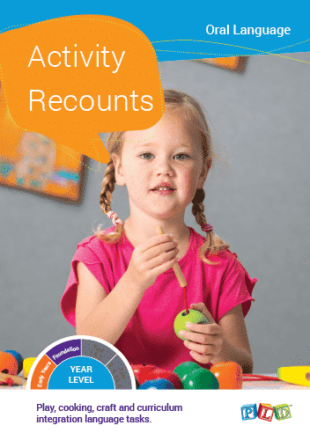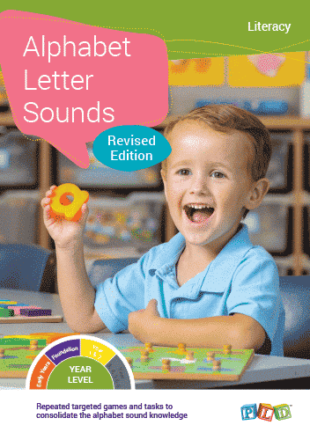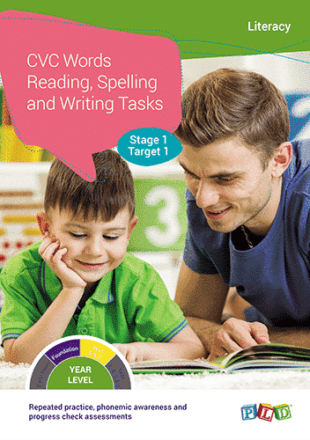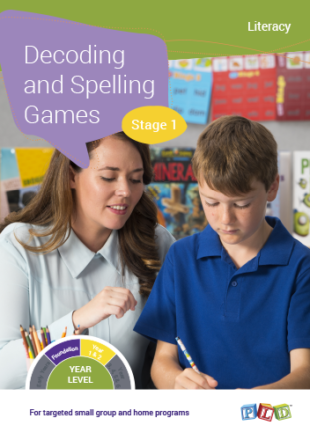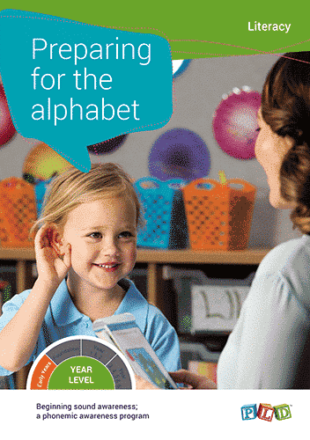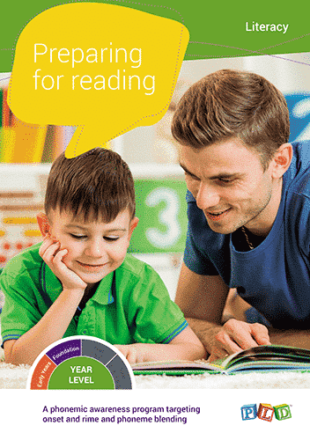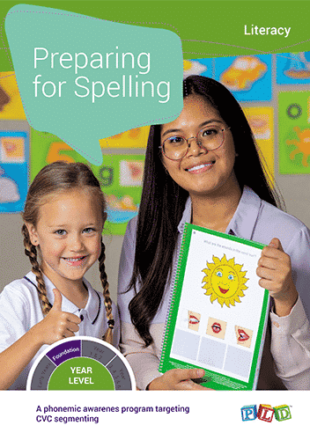Age
Showing 385–400 of 458 results
-
Activity Recounts
Developing language within the early years
Introduction to the Program This program is designed to develop early narrative skills in young children by encouraging them to retell simple activities and events. Through structured activities, children learn to sequence events, expand their vocabulary, and improve their ability to speak in connected sentences. The Program Includes: Activity retell posters suitable for 3-5 year olds Multiple activity retell templates and examples across 4 themes Vocabulary focused on real-life categories relevant to children Cooking Arts and Crafts Play Household Other Programs within the Range: Picture Book Retelling – Step 1 Developing News Telling and Narrative Skills for 4 Year Olds Links to the Teaching Sequence Manuals This product is mentioned in the Early Years Teaching Sequence Manual
$82.50$82.50 incl. GST[flipbook-popup id=''][/flipbook-popup] -
Alphabet Letter Sounds
An instruction manual (with games and worksheets) targeting letter sounds and letter formation for 4 to 6 year olds.
Introduction to the Program These alphabet sound activities are designed to support early literacy development by helping children recognise and pronounce the sounds associated with each letter of the alphabet. The cards are versatile and can be used for a variety of activities that reinforce letter-sound relationships, which are foundational for reading and writing. The Program Includes: 26 letter sounds taught across 4 groups Group 1: s, p, n, i, a, t Group 2: m, r, h, e, d, c Group 3: f, l, g, o, u b Group 4: w, j, v, k, z, y, q, x Multiple activities to develop letter-sound knowledge and formation Alphabet Sound Picture Matching Game Boards Letter Formation Initial Sound Identification Other Programs within the Range: Alphabet the Multi Sensory Way- Foundation Font Learning to Blend Onset and Rime Links to the Teaching Sequence Manuals This product is mentioned in the Early Years Teaching Sequence Manual
$82.50$82.50 incl. GST[flipbook-popup id=''][/flipbook-popup] -
CCVC and CVCC Reading, Spelling and Writing Tasks – Stage 1 – Target 3
Repeated practice, phonemic awareness and progress check assessments.
Introduction to the Program This program is designed to support the development of early reading and spelling skills by focusing on CCVC and CVCC word structures. The resources focus on incorporating phonemic awareness and multi-sensory strategies to segment and blend words with adjacent consonants. The Program Includes: Sound out & Spell CCVC & CVCC words Sentence reading & writing of CCVC & CVCC words 4 Sound Phonemic Awareness Cards Other Programs within the Range: CVC Words Reading, Spelling and Writing Tasks Early Stage 1 – Reading, Spelling and Writing Tasks – Target 2 Late Stage 1 – Reading, Spelling and Writing Tasks -Target 4 Reading, Spelling and Writing Tasks: CVC to Target 4 – Bundle Links to the Teaching Sequence Manuals This product is mentioned in the Foundation Teaching Sequence Manual
$82.50$82.50 incl. GST[flipbook-popup id=''][/flipbook-popup] -
CVC Words Reading, Spelling and Writing Tasks
Worksheet tasks and colour phonemic awareness cards.
Introduction to the Program This program is designed to support the development of early reading and spelling skills by focusing on CVC word structures. The resources focus on incorporating phonics, phonemic awareness and multi-sensory strategies to segment and blend CVC words. The Program Includes: Sound out & Spell CVC words within 4 groups of sounds Group 1: s, p, n, i, a, t Group 2: m, r, h, e, d, c Group 3: f, l, g, o, u b Group 4: w, j, v, k, z, y, q, x Sentence reading & writing of CVC words 3 Sound Phonemic Awareness Cards Other Programs within the Range: Early Stage 1 – Reading, Spelling and Writing Tasks – Target 2 CCVC and CVCC Reading, Spelling and Writing Tasks – Stage 1 – Target 3 Late Stage 1 – Reading, Spelling and Writing Tasks – Target 4 Reading, Spelling and Writing Tasks: CVC to Target 4 – Bundle Links to the Teaching Sequence Manuals This product is mentioned in the Foundation Teaching Sequence Manual
$82.50$82.50 incl. GST[flipbook-popup id=''][/flipbook-popup] -
Early Stage 1 Reading, Spelling and Writing Tasks – Target 2
Repeated practice, phonemic awareness and progress check assessments with A4 Colour Cards and Worksheets.
Introduction to the Program This program is designed to support the development of early reading and spelling skills by focusing on CVC word structures with Target 2 digraphs. The resources focus on incorporating phonics, phonemic awareness and multi-sensory strategies to segment and blend CVC words with Target 2 digraphs. The Program Includes: Sound out & Spell CVC words with 8 phonic concepts ‘th’ (voiced) & ‘th’ (voiceless) ‘sh’ ‘ch’ ‘ee’ ‘oo’ (long) & ‘oo’ (short) ‘ck’ Sentence reading & writing of CVC words with 8 phonic concepts 3 Sound Phonemic Awareness Cards with 8 phonic concepts Other Programs within the Range: CVC Words Reading, Spelling and Writing Tasks CCVC and CVCC Reading, Spelling and Writing Tasks – Stage 1 – Target 3 Late Stage 1 – Reading, Spelling and Writing Tasks – Target 4 Reading, Spelling and Writing Tasks: CVC to Target 4 – Bundle Links to the Teaching Sequence Manuals This product is mentioned in the Foundation Teaching Sequence Manual
$82.50$82.50 incl. GST[flipbook-popup id=''][/flipbook-popup] -
Late Stage 1 – Reading, Spelling and Writing Tasks – Target 4
Repeated practice, phonemic awareness and progress check assessments with A4 Colour Cards and Worksheets.
Introduction to the Program This program is designed to support the development of early reading and spelling skills by focusing on CVC word structures with Target 4 phonic concepts. The resources focus on incorporating phonics, phonemic awareness and multi-sensory strategies to segment and blend CVC words with Target 4 phonic concepts. The Program Includes: Sound out & Spell CVC words with 7 phonic concepts ‘ay’ & ‘ar’ ‘or’ ‘ai’ ‘ee’ ‘oy’ & ‘oi’ (short) ‘er’ (as in ‘her’ & ‘finger’) Sentence reading & writing of CVC words with 7 phonic concepts 3 Sound Phonemic Awareness Cards with 7 phonic concepts Other Programs within the Range: CVC Words Reading, Spelling and Writing Taskss Early Stage 1 – Reading, Spelling and Writing Tasks – Target 2 CCVC and CVCC Reading, Spelling and Writing Tasks – Stage 1 – Target 3 Reading, Spelling and Writing Tasks: CVC to Target 4 – Bundle Links to the Teaching Sequence Manuals Year 1 & 2 Teaching Sequence Manual
$82.50$82.50 incl. GST[flipbook-popup id=''][/flipbook-popup] -
Phonic and Sight Word Sequence
Outlining the relationship between letters and sounds.
Introduction to the Program This essential guide outlines the PLD approach to implementing reading and spelling instruction from Foundation to Year 6. The Program Includes: A structured whole-school scope and sequence, outline phonic concepts, morphology, reading and spelling words, regular and irregular high-frequency words. Termly assessments to establish the range in ability and reviewing progress. Stages 1-3 focus on teaching essential phonic concepts and common-bound morpheme suffixes. Stages 4-6 focus on extending alternative spellings of phonic concepts and more sophisticated word attack spelling based on syllables, prefixes, suffixes and morphemes. Difficulty acquiring Stage 1 concept assessments to investigate slow-to-progress students. Posters and guidelines on the explicit teaching of reading and spelling words in phonemes or syllables and irregular high-frequency words. Other Programs within the Range: CVC Words Reading, Spelling and Writing Tasks Early Stage 1 – Reading, Spelling and Writing Tasks – Target 2 CCVC and CVCC Reading, Spelling and Writing Tasks – Stage 1 – Target 3 Reading, Spelling and Writing Tasks: CVC to Target 4 – Bundle Links to the Teaching Sequence Manuals This product can be used to support the implementation of the: Foundation Teaching Sequence Manual Year 1 & 2 Teaching Sequence Manual Year 3-6 Teaching Sequence Manual
$82.50$82.50 incl. GST[flipbook-popup id=''][/flipbook-popup] -
Decoding and Spelling Games – Stage 1
A program to develop single word decoding and spelling skills for students operating at Stage 1. Games and tasks for targeted small groups and home programs.
Introduction to the Program This program is designed to reinforce the foundational skills of decoding and spelling of Stage 1 concepts. It provides structured practice in the form of simple games to help students develop accuracy and automaticity in reading and spelling early phonic concepts. The Program Includes: Stage 1- Target 1 CVC decoding and spelling games Group 1: s, p, n, i, a, t Group 2: m, r, h, e, d, c Group 3: f, l, g, o, u b Group 4: w, j, v, k, z, y, q, x Stage 1- Target 2 decoding and spelling games incorporating digraphs ‘sh’ ‘ch’ ‘th’ ‘sh’, ‘ch’, & ‘th’ combined ‘oo’ ‘ee’ ‘ck’ ‘oo’, ‘ee’ & ‘ck’ combined Stage 1- Target 3 decoding and spelling games with CCVC and CVCC words CCVC CVCC Stage 1 – Target 4 decoding and spelling games incorporating extended vowels and digraph knowledge ‘ng’ ‘ay’ ‘or’ ‘ar’ ‘ai’ ‘al(l)’ ‘wh’ & ‘qu’ Decoding and spelling activities for each phonic Target Decoding & spelling frames for word building and phoneme manipulation tasks Sound out & spell pictures with mouth cues Decoding and spelling games for each phonic Target Board games Cards for ‘Go Fish’, ‘Memory’ or ‘Snap’ games Bingo Other Programs within the Range: Decoding and Spelling Games CCVC and CVCC Reading, Spelling and Writing Tasks – Stage 1 – Target 3 Decoding and Spelling Games Bundle – Stages 1 & 2 Links to the Teaching Sequence Manuals This product can be used to support the implementation of the: Foundation Teaching Sequence Manua Year 1 & 2 Teaching Sequence Manual
$82.50$82.50 incl. GST[flipbook-popup id=''][/flipbook-popup] -
First Reading Words
A program for 4 to 6 year olds that introduces CVC reading into the early years.
Designed by a Speech Pathologist for use in schools and the home, First Reading Words presents a progressive approach to decoding (or “sounding-out”) some of the earliest reading words. Suitable for children age 4 to 6, this resource also provides ample practice reading simple regular alphabet words. Includes activities for both single word and sentence reading. Includes 10 game variations for the game boards. Includes explicit instructions on the cards and game boards. Includes: 78 x Single Word Reading Colour Cards 42 x Sentence Reading Colour Cards 2 x A3 Colour Game Boards The programs within the range include: First Spelling Words – Set 1 First Spelling Words – Set 2 First Reading Words First Writing Activities This resource is mentioned in the Foundation Teaching Sequence Manual on page 8.
$82.50$82.50 incl. GST[flipbook-popup id=''][/flipbook-popup] -
First Reading Words
[flipbook-popup id=''][/flipbook-popup] -
First Spelling Words – Set 1
A program for 5 to 6 year olds that introduces CVC word spelling with phonics into the early years.
Designed by Speech Pathologists for teachers and parents, First Spelling Words – Set 1 for students aged 5 to 6, includes 51 activities in three different card templates in flip book format which increase in difficulty. Explicit instruction cards with seven recommended options for use are included with the card templates. The single word spelling cards are divided into 4 progressive steps CVC words which the resource: STEP 1: 6 alphabet sounds s, a, t, p, i, n (cards with yellow borders) Example: sip, tap, pin, pan, nap, tip, tin, sit, sat, pip, nip, pat. STEP 2: 12 alphabet sounds: Step 1 plus m, r, h, e, d, c (Cards with blue borders.) Example: net, cat, hit, hen, men, man, sad, rat, ten, map, pen, mat. STEP 3: 18 alphabet sounds: Step 1 and 2 plus f, l, g, o, u, b (Cards with green borders.) Example: cot, run, pot, dog, gum, log, lip, cup, bat, leg, sun, rug. STEP 4: Basically all of the alphabet (Cards with red borders.) Example: jug, van, jog, jet, jam, vet, wet, wig, wax, fox, win, six. The programs within the range include: First Spelling Words – Set 1 First Spelling Words – Set 2 First Reading Words First Writing Activities This resource is mentioned in the Foundation Teaching Sequence Manual on page 8.
$82.50$82.50 incl. GST[flipbook-popup id=''][/flipbook-popup] -
Generating Narratives – Set 1
Building Verbal and Written Expression Through Picture Prompts
Generating Narratives: Set1 supports Year 1 to 6 students develop verbal and written storytelling skills. Using picture prompts, this resource breaks narratives into three key components: An introduction to set the scene. A complication or problem. Characters' thoughts and feelings. This program is ideal for building students' confidence in both oral and written expression, whilst fostering creativity and a deeper understanding of story structure. Program Includes: A4 book: Spiral-bound, full colour and no preparation required. 10 Storylines & Picture Cards: each with three accompanying A4 Picture Cards illustrating narrative structure (30 cards in total). Included story themes: Scarecrow Pet on the Loose Surprise Hatch Late for School Car Accident Flooded Town Escape Rabbit Campsite Danger Bolting Horse Baby Bird Falling Narrative Structure Cards: includes 10 x A4 coloured narrative structure poster cards for display. Implementation: Picture cards guide students through introductions, complications and emotions, providing repeated practise in generating ideas and composing stories. Other Programs within the Range: Generating Narratives – Set 2 Links to the Teaching Sequence Manuals: This product can be used to support the implementation of the Year 1 and 2 Teaching Sequence Manual on Page 27 This product can be used to support the implementation of the Year 3, 4, 5, and 6 Teaching Sequence Manual on Page 34
$45.00$45.00 incl. GST[flipbook-popup id=''][/flipbook-popup] -
Preparing for the Alphabet
Beginning sound awareness: a phonemic awareness program
Preparing for the alphabet is designed for students aged 4 to 5 and sets about the basics required for pre-literacy. The explicit 5 minute sessions contain an outline of instructions and guidelines on how to effectively teach initial sound awareness. These instructions can form the basis of assistant and parent education. When Preparing for the alphabet is used in conjunction with PLD’s Pre-Literacy Screening this forms a significant component in a school’s early intervention strategy. Children require the phonemic awareness skill of initial sound awareness in order to fully understand the alphabetic system. Why? When children are conscious of single sounds (i.e. they can ‘hear’ and ‘say’ the beginning sounds in words) only then does the alphabetic system make sense; as the alphabetic symbols represent sounds (or phonemes) in words. For example; When a child can identify that ‘sun’ starts with a ‘sssss’ and ‘tap’ starts with a ‘t’ it is then an ideal time to introduce the alphabetic symbols that correspond with the sounds that the child is aware of. Too often the alphabet is introduced without any explicit attention to initial sound awareness. This must-have resource includes: Instructions that provide clear guidelines on how to effectively teach initial sound awareness Screening tool to determine readiness for an alphabet program 27 x mouth cards for continuant sounds with 120 x small activity picture cards 16 x mouth cards for stop sounds with 72 small activity picture cards The programs within the range include: Preparing for the Alphabet Preparing for Spelling Preparing for Reading This product is mentioned in the Early Years Teaching Sequence Manual on page 5.
$82.50$82.50 incl. GST[flipbook-popup id=''][/flipbook-popup] -
Preparing for Reading
A phonemic awareness program for 4 and 5 year olds targeting CVC blending.
One of the most significant pre-requisites for reading, spelling and writing is phonemic awareness. Phonemic awareness is strongly associated with early literacy achievement. In Preparing for reading for 4 and 5 year olds, blending is targeted as blending represents an immediate precursor to decoding ability. This resource contains coloured card sets recommended for explicit 5 minute instruction sessions and provide clear guidelines on how to effectively teach blending. These instructions can form the basis of assistant and parent education. The PLD developmental 5 step phonological awareness process has been designed by Speech Pathologists for use in schools. When used in conjunction with PLD’s pre-literacy screening, this program forms a significant component in a school’s preventative early intervention strategy. Phonemic Awareness Readiness for Reading The phonemic awareness pre-requisite skill involved in reading simple regular CVC [consonant-vowel-consonant] words such as ‘fig’, ‘tin’ and ‘mat’ is the skill of blending. First students must learn to blend at an onset and rime level. E.g. ‘Listen carefully and put these sounds together and guess this word:’ ‘f’ (one second pause) ‘ig’?’ Students then learn to blend at the phonemic or individual sound level: E.g. ‘Listen carefully and put these sounds together and guess this word; ‘m’ (one second pause) ‘a’ (one second pause) ‘t’? Answer: ‘mat’. Features: Instruction manual (24 pages) 5 different blending activities with instructions 125+ colour cards, 3 x game boards The programs within the range include: Preparing for the Alphabet Preparing for Spelling Preparing for Reading This product is mentioned in the Early Years Teaching Sequence Manual on page 8 and the Foundation Teaching Sequence Manual on page 7 and the Year 1 & 2 Teaching Sequence Manual on page 19. Generous discounts apply for bulk orders 5 to 9 copies – 15% discount applies 10+ copies – 20% discount applies
$82.50$82.50 incl. GST[flipbook-popup id=''][/flipbook-popup] -
Preparing for Spelling
A phonemic awareness program for 4 to 5 year olds targeting CVC segmenting.
One of the most significant pre-requisites for reading, spelling and writing is phonemic awareness. Phonemic awareness is strongly associated with early literacy achievement. In Preparing for Spelling for 4 and 5 year olds, segmentation is targeted as segmentation represents an immediate precursor to CVC spelling ability. This resource contains coloured card sets recommended for explicit 5 minute instruction sessions and provide clear guidelines on how to effectively teach segmentation. These instructions can form the basis of assistant and parent education. The PLD developmental 5 step phonological awareness process has been designed by Speech Pathologists for use in schools. When used in conjunction with PLD’s pre-literacy screening, this program forms a significant component in a school’s preventative early intervention strategy. Phonemic Awareness Readiness for Spelling The phonemic awareness pre-requisite skill involved in spelling simple regular CVC [consonant-vowel-consonant] words such as ‘tap’, ‘sun’ and ‘log’ is the skill of phonemic segmentation. E.g. ‘What sounds can you ‘hear’ (i.e. identify) in the word ‘peg’?’ Answer: ‘p’… ‘e’… ‘g’. The simple but powerful learning activities in this book provide multiple opportunities for students to rehearse the core pre-requisite skill of blending. Aim for little but often (i.e. 3 – 5 minute activities several times a week) until the target skill has been established. Once established in addition to the alphabet sounds simple early reading tasks may be introduced. Features: Instruction manual (24 pages) 5 different blending activities with instructions 125+ colour cards, 3 x game boards Features: Instruction manual (24 pages) 5 different blending activities with instructions 125+ colour cards, 3 x game boards The programs within the range include: Preparing for the Alphabet Preparing for Spelling Preparing for Reading This resource is mentioned in the Foundation Teaching Sequence Manual on page 7. Generous discounts apply for bulk orders 5 to 9 copies – 15% discount applies 10+ copies – 20% discount applies
$82.50$82.50 incl. GST[flipbook-popup id=''][/flipbook-popup] -
Phonic Charts – Stage 1



